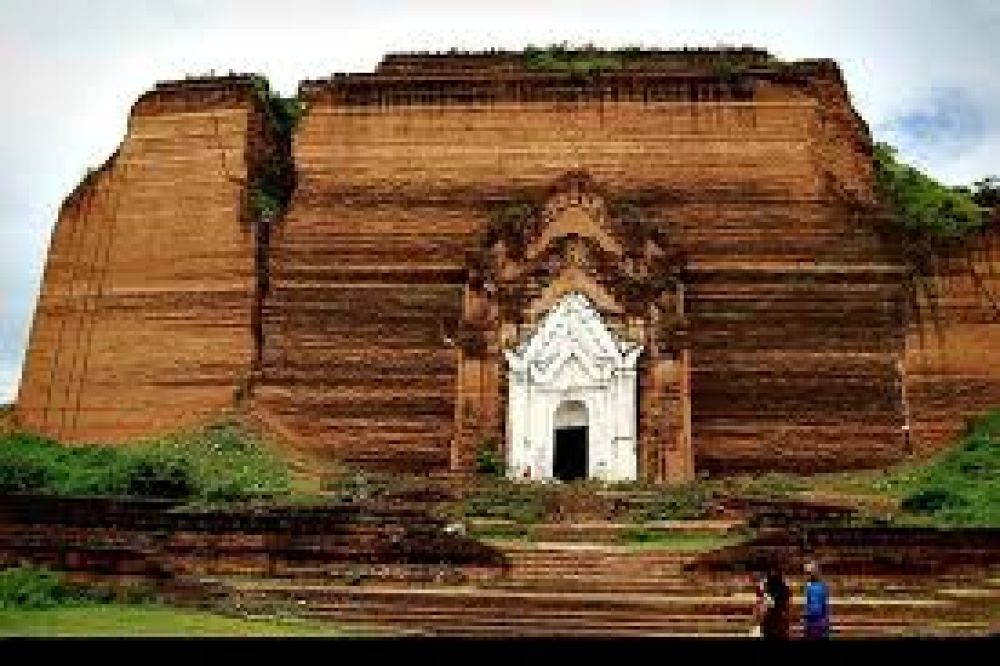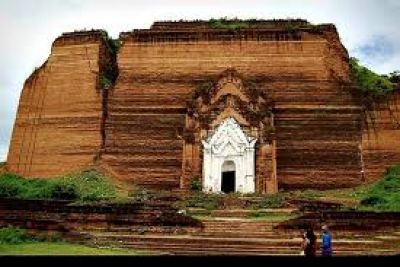

The Mingun Pahtodawgyi is an unfinished monument that stands as a testament to the grand plans of King Bodawpaya. It was supposed to be the largest stupa in the world, but construction was abandoned after the king's death. Now, visitors can climb the remaining structure for a panoramic view of the surrounding area, including the nearby Mingun Bell, which is considered the world's largest ringing bell. The journey to the top can be quite a climb, but the experience offers a glimpse into Myanmar's rich history and culture. The climb also allows for an up-close look at the cracks caused by an earthquake in 1839. Local legends and myths abound, making a visit here not just a physical adventure but a dive into the country's lore.
The Mingun Bell is a must-visit when you're in the area of the Mingun Pahtodawgyi. Cast in the early 19th century, this 90-ton bronze bell was created to complement the Pahtodawgyi. Despite the stupa's non-completion, the bell remains an impressive relic. Visitors can stand inside the bell and even give it a gentle ring, experiencing its deep resounding tone. The sound of the bell is said to be an auspicious one, spreading positive vibrations. A visit to the Mingun Bell is not only about the physical experience but also about understanding Myanmar's cultural heritage, as the bell plays a significant role in the local Buddhist traditions.
One of the most enjoyable ways to visit Mingun is by taking a scenic river cruise along the Ayeyarwady River from Mandalay. The journey allows visitors to admire the riverside scenery and local life. Many cruises offer additional amenities, including meals and guided tours. Upon arriving in Mingun, visitors can explore the Mingun Pahtodawgyi, Mingun Bell, and other nearby attractions. The cruise typically offers return trips as well, making it a convenient and pleasant way to experience this part of Myanmar. Plus, the river's cool breeze provides respite from the heat and a chance to see river transport in action, a vital part of Myanmar's economy.
Close to the Mingun Pahtodawgyi is the Hsinbyume Pagoda, a stark white structure built in 1816 by Prince Bagyidaw. It is dedicated to the memory of his first wife and is modeled after the mythical Sulamani Pagoda. The architecture is unique, with seven concentric terraces representing the seven mountain ranges around Mount Meru according to Buddhist cosmology. Visitors can walk around the pagoda and up the terraces, exploring the various niches that house small shrines and statues. The pagoda offers striking photographic opportunities and a peaceful atmosphere for contemplation away from the more crowded attractions.
The Mingun Archaeological Museum houses a collection of artifacts related to the Mingun temple complex and the reign of King Bodawpaya. Objects on display include items that were intended for use within the Pahtodawgyi, such as religious statues and utensils, as well as items representing everyday life during that period. The museum is small but informative, offering context to the nearby structures and giving visitors a deeper understanding of the history and culture of Mingun and Myanmar. It's a short walk from the main attractions and provides a respite from the sun with its shaded areas.
Mingun is not just about its historical structures; it's also home to a vibrant local community. Visitors can take a guided tour to walk through the village streets, meeting local craftspeople and observing daily life away from the tourist sites. This can include visiting local workshops where traditional crafts are still practiced, such as pottery and weaving, or having a simple meal or tea at a local café. Engaging with the community offers a rich cultural exchange and an opportunity to support local artisans by purchasing their handcrafted goods as souvenirs.
For those with a passion for photography, Mingun offers a treasure trove of subjects: from the textures of the unfinished stupa to the daily life within the village. Take a leisurely walk through the area to capture the contrasts between the ancient ruins and the vibrancy of the local life. Early morning and late afternoon provide the best light for photographs, with softer shadows and a golden glow that enhances the beauty of the landscape. A photography walk may be self-guided or joined with a group, led by a local photographer who can provide insights into the best spots and techniques to make the most of the scenic locale.
The banks of the Ayeyarwady River near Mingun are the perfect location to watch the sunset. As the day winds down, visitors gather to witness the sky turning colorful hues. The reflection on the river's surface amplifies the natural spectacle, providing a serene moment to round off a day of exploration. It's a chance to see the locals, who also come to enjoy the evening breeze and the calming effect of the river. No trip to Mingun is complete without taking the time to soak in this daily wonder, which underscores the timeless connection the people of Myanmar have with this life-giving river.
Myanmar's cuisine is as rich and diverse as its culture, and trying a traditional Burmese meal should be on every visitor's list. In Mingun, several small restaurants and food stalls offer a range of local dishes. Typical meals might include Mohinga, a delicious fish-based noodle soup, or tea leaf salad, a unique dish featuring fermented tea leaves. Eating is an important aspect of social life in Myanmar, and visitors are often struck by the hospitality and the eagerness of locals to share their culinary traditions. This experience will not only tantalize taste buds but also provide an authentic insight into the daily life and culture of the Burmese people.
The local market in Mingun is a great place to shop for authentic Burmese handicrafts. Visitors can browse through the stalls for handmade items such as traditional longyi (cloth worn like a skirt), lacquerware, jewelry, and other souvenirs. By purchasing these goods, travelers not only get to take a piece of Myanmar home with them but also support the local economy and help preserve traditional crafts. The market experience is also enriched by the interaction with the friendly vendors, providing a glimpse into the commerce and craftsmanship that have long been a part of Mingun's culture.
